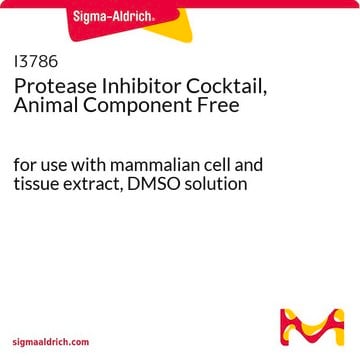539136
Protease Inhibitor Cocktail IV
liquid, for the inhibition of serine proteases, cysteine proteases, aspartic proteases and metalloproteases. This small molecule/inhibitor is primarily used for Protease Inhibitors applications.
Sinonimo/i:
Protease inhibitor cocktail
About This Item
Prodotti consigliati
product name
Protease Inhibitor Cocktail Set IV, The Protease Inhibitor Cocktail Set IV controls the activity of Protease. This small molecule/inhibitor is primarily used for Protease Inhibitors applications.
Forma fisica
liquid
Produttore/marchio commerciale
Calbiochem®
Condizioni di stoccaggio
OK to freeze
Condizioni di spedizione
wet ice
Temperatura di conservazione
−20°C
Categorie correlate
Descrizione generale
Specificità
Applicazioni
Azioni biochim/fisiol
aspartic-, cysteine-, metallo-, and serine-proteases
Attenzione
Stato fisico
Ricostituzione
Altre note
Note legali
Avvertenze
Warning
Indicazioni di pericolo
Consigli di prudenza
Classi di pericolo
Acute Tox. 4 Oral - Aquatic Acute 1 - Aquatic Chronic 1 - Eye Irrit. 2 - Skin Irrit. 2
Codice della classe di stoccaggio
10 - Combustible liquids
Classe di pericolosità dell'acqua (WGK)
WGK 3
Punto d’infiammabilità (°F)
188.6 °F - Information refers to the main ingredient.
Punto d’infiammabilità (°C)
87 °C - Information refers to the main ingredient.
Certificati d'analisi (COA)
Cerca il Certificati d'analisi (COA) digitando il numero di lotto/batch corrispondente. I numeri di lotto o di batch sono stampati sull'etichetta dei prodotti dopo la parola ‘Lotto’ o ‘Batch’.
Possiedi già questo prodotto?
I documenti relativi ai prodotti acquistati recentemente sono disponibili nell’Archivio dei documenti.
I clienti hanno visto anche
Il team dei nostri ricercatori vanta grande esperienza in tutte le aree della ricerca quali Life Science, scienza dei materiali, sintesi chimica, cromatografia, discipline analitiche, ecc..
Contatta l'Assistenza Tecnica.
















